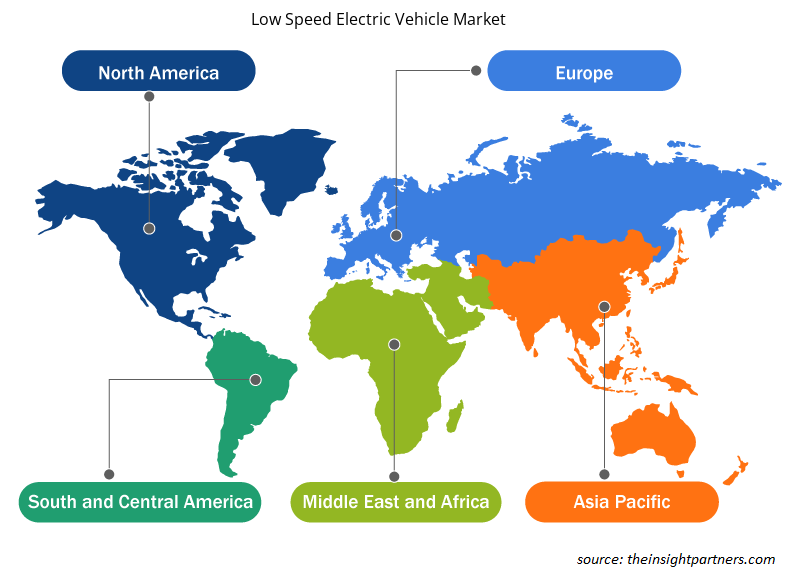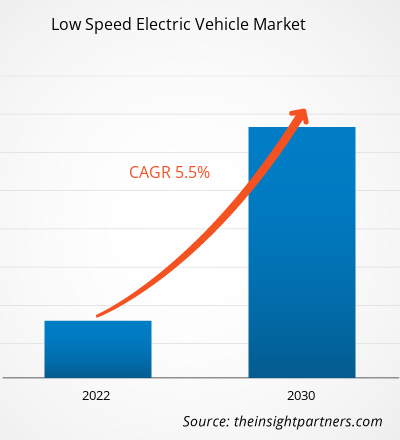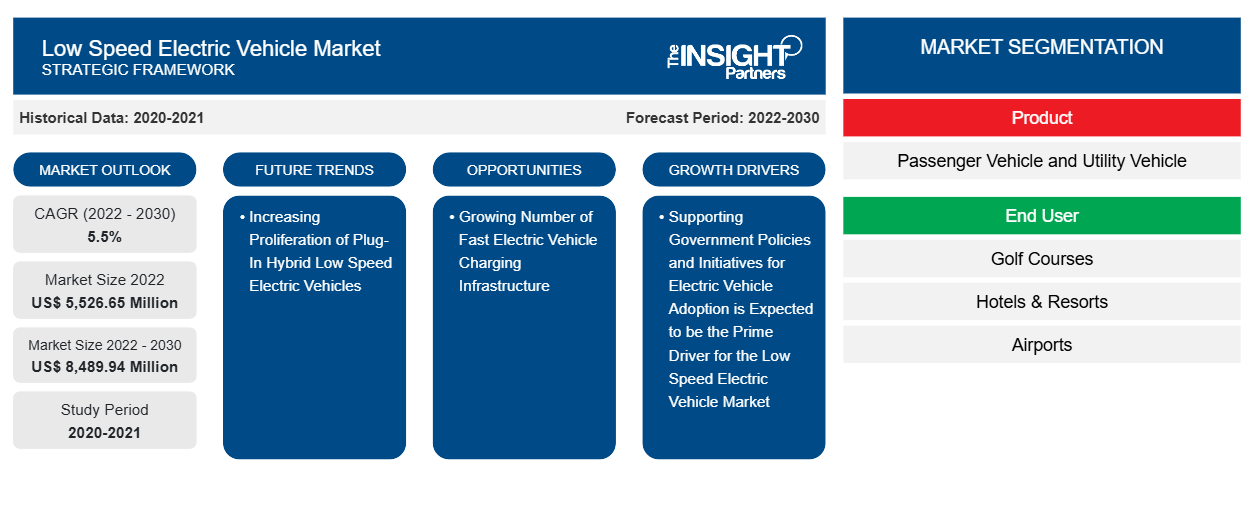بلغت قيمة سوق المركبات الكهربائية منخفضة السرعة 5,526.65 مليون دولار أمريكي في عام 2022 ومن المتوقع أن تسجل معدل نمو سنوي مركب بنسبة 5.5٪ من عام 2022 إلى عام 2030، لتصل إلى 8,489.94 مليون دولار أمريكي بحلول عام 2030. ومن المرجح أن يظل التركيز المتزايد على زيادة كفاءة الوقود اتجاهًا رئيسيًا في السوق.
تحليل سوق المركبات الكهربائية منخفضة السرعة
لقد شهد سوق المركبات الكهربائية منخفضة السرعة العالمي تحولاً ملحوظًا في السنوات القليلة الماضية، مما يشير إلى زيادة كبيرة في تجارة وتبني المركبات الصديقة للبيئة. في عام 2022، خضعت ديناميكيات استيراد السيارات الكهربائية والهجينة لتطور مذهل، مما يعكس تفضيلًا متزايدًا لحلول التنقل المستدامة. والجدير بالذكر أن التحول الكبير في أنواع السيارات الكهربائية والهجينة المستوردة يدفع تطوير سوق المركبات الكهربائية منخفضة السرعة على مستوى العالم.
نظرة عامة على سوق المركبات الكهربائية منخفضة السرعة
لقد شهد سوق المركبات الكهربائية منخفضة السرعة تحولاً ملحوظًا حيث شهدت مبيعات المركبات الكهربائية بالكامل اتجاهًا تصاعديًا. ومن المتوقع أن يؤدي تفضيل المستهلكين للبدائل الصديقة للبيئة والابتعاد عن السيارات التي تعمل بالديزل إلى دفع تطور سوق المركبات الكهربائية منخفضة السرعة خلال فترة التنبؤ. وتنفذ صناعة السيارات حلولاً بديلة لتلبية لوائح الانبعاثات المتطورة التي فرضها المشرعون المختلفون.
قم بتخصيص هذا التقرير ليناسب متطلباتك
ستحصل على تخصيص لأي تقرير - مجانًا - بما في ذلك أجزاء من هذا التقرير، أو تحليل على مستوى الدولة، وحزمة بيانات Excel، بالإضافة إلى الاستفادة من العروض والخصومات الرائعة للشركات الناشئة والجامعات
-
احصل على أهم اتجاهات السوق الرئيسية لهذا التقرير.ستتضمن هذه العينة المجانية تحليلاً للبيانات، بدءًا من اتجاهات السوق وحتى التقديرات والتوقعات.
محركات وفرص سوق المركبات الكهربائية منخفضة السرعة
دعم السياسات والمبادرات الحكومية لتبني المركبات الكهربائية لصالح السوق
إن التلوث البيئي المتزايد بسبب الوقود الأحفوري هو أحد المخاوف الرئيسية للحكومة. لتقليل مستوى التلوث البيئي، تؤكد الحكومات المختلفة على أن المستهلكين يتبنون بدائل أكثر نظافة واستدامة وصديقة للبيئة من خلال تقديم خصومات خاصة على المبيعات والحوافز والعروض المربحة والمزايا الضريبية. تعد الصين واليابان والاتحاد الأوروبي والهند وكندا وكوريا الجنوبية من بين المناطق الجغرافية الرئيسية حيث تعمل الحكومات بنشاط على تعزيز تبني المركبات الكهربائية منخفضة السرعة، وهو ما من المتوقع أن يدفع تطور سوق المركبات الكهربائية منخفضة السرعة خلال فترة التنبؤ.
ارتفاع القدرة على تحمل تكاليف المركبات الكهربائية منخفضة السرعة
تشكل البطاريات جزءًا رئيسيًا من المركبات الكهربائية . وبفضل التقدم التكنولوجي وانخفاض أسعار البطاريات، أصبحت المركبات الكهربائية أكثر بأسعار معقولة. ومن المتوقع أن يؤدي تزايد القدرة على تحمل التكاليف والمبادرات الحكومية المتزايدة نحو تقديم تخفيضات ضريبية لاختيار المركبات الكهربائية إلى دفع نمو سوق المركبات الكهربائية منخفضة السرعة في السنوات القادمة.
تقرير تحليل تجزئة سوق المركبات الكهربائية منخفضة السرعة
إن القطاعات الرئيسية التي ساهمت في اشتقاق تحليل سوق المركبات الكهربائية منخفضة السرعة هي المنتج والمستخدم النهائي.
- بناءً على المنتج، يتم تقسيم سوق المركبات الكهربائية منخفضة السرعة إلى مركبات الركاب ومركبات المرافق . احتلت شريحة مركبات الركاب حصة سوقية أكبر في عام 2022.
- بناءً على المستخدمين النهائيين، يتم تقسيم سوق المركبات الكهربائية منخفضة السرعة إلى ملاعب الجولف والفنادق والمنتجعات والمطارات والمباني السكنية والتجارية وغيرها. احتل قطاع ملاعب الجولف حصة سوقية أكبر في عام 2022.
تحليل حصة سوق المركبات الكهربائية منخفضة السرعة حسب المنطقة الجغرافية
ينقسم النطاق الجغرافي لتقرير سوق المركبات الكهربائية منخفضة السرعة بشكل أساسي إلى خمس مناطق: أمريكا الشمالية، ومنطقة آسيا والمحيط الهادئ، وأوروبا، والشرق الأوسط وأفريقيا، وأمريكا الجنوبية والوسطى.
يشمل نطاق تقرير سوق المركبات الكهربائية منخفضة السرعة أمريكا الشمالية (الولايات المتحدة وكندا والمكسيك) وأوروبا (روسيا والمملكة المتحدة وفرنسا وألمانيا وإيطاليا وبقية أوروبا) وآسيا والمحيط الهادئ (كوريا الجنوبية والهند وأستراليا واليابان والصين وبقية آسيا والمحيط الهادئ) والشرق الأوسط وأفريقيا (المملكة العربية السعودية وجنوب إفريقيا والإمارات العربية المتحدة وبقية الشرق الأوسط وأفريقيا) وأمريكا الجنوبية والوسطى (الأرجنتين والبرازيل وبقية أمريكا الجنوبية والوسطى). من حيث الإيرادات، سيطرت أمريكا الشمالية على حصة سوق المركبات الكهربائية منخفضة السرعة في عام 2022. تعد منطقة آسيا والمحيط الهادئ ثاني أكبر مساهم في سوق المركبات الكهربائية منخفضة السرعة العالمية، تليها أوروبا.
رؤى إقليمية حول سوق المركبات الكهربائية منخفضة السرعة
لقد قام المحللون في Insight Partners بشرح الاتجاهات والعوامل الإقليمية المؤثرة على سوق المركبات الكهربائية منخفضة السرعة طوال فترة التوقعات بشكل شامل. يناقش هذا القسم أيضًا قطاعات سوق المركبات الكهربائية منخفضة السرعة والجغرافيا في جميع أنحاء أمريكا الشمالية وأوروبا ومنطقة آسيا والمحيط الهادئ والشرق الأوسط وأفريقيا وأمريكا الجنوبية والوسطى.

- احصل على البيانات الإقليمية المحددة لسوق المركبات الكهربائية منخفضة السرعة
نطاق تقرير سوق المركبات الكهربائية منخفضة السرعة
| سمة التقرير | تفاصيل |
|---|---|
| حجم السوق في عام 2022 | 5,526.65 مليون دولار أمريكي |
| حجم السوق بحلول عام 2030 | 8,489.94 مليون دولار أمريكي |
| معدل النمو السنوي المركب العالمي (2022 - 2030) | 5.5% |
| البيانات التاريخية | 2020-2021 |
| فترة التنبؤ | 2022-2030 |
| القطاعات المغطاة |
حسب المنتج
|
| المناطق والدول المغطاة |
أمريكا الشمالية
|
| قادة السوق وملفات تعريف الشركات الرئيسية |
|
كثافة اللاعبين في سوق المركبات الكهربائية منخفضة السرعة: فهم تأثيرها على ديناميكيات الأعمال
يشهد سوق المركبات الكهربائية منخفضة السرعة نموًا سريعًا، مدفوعًا بالطلب المتزايد من المستخدم النهائي بسبب عوامل مثل تفضيلات المستهلكين المتطورة والتقدم التكنولوجي والوعي المتزايد بفوائد المنتج. ومع ارتفاع الطلب، تعمل الشركات على توسيع عروضها والابتكار لتلبية احتياجات المستهلكين والاستفادة من الاتجاهات الناشئة، مما يؤدي إلى زيادة نمو السوق.
تشير كثافة اللاعبين في السوق إلى توزيع الشركات أو المؤسسات العاملة في سوق أو صناعة معينة. وهي تشير إلى عدد المنافسين (اللاعبين في السوق) الموجودين في مساحة سوق معينة نسبة إلى حجمها أو قيمتها السوقية الإجمالية.
الشركات الرئيسية العاملة في سوق المركبات الكهربائية منخفضة السرعة هي:
- شركة تيكسترون
- شركة ياماها موتور المحدودة
- سيارة النادي
- شركة تورو
- رينو SA
- ستار إي في
إخلاء المسؤولية : الشركات المذكورة أعلاه ليست مرتبة بأي ترتيب معين.

- احصل على نظرة عامة على أهم اللاعبين الرئيسيين في سوق المركبات الكهربائية منخفضة السرعة
أخبار سوق السيارات الكهربائية منخفضة السرعة والتطورات الأخيرة
يتم تقييم سوق المركبات الكهربائية منخفضة السرعة من خلال جمع البيانات النوعية والكمية بعد البحث الأولي والثانوي، والتي تتضمن منشورات الشركات المهمة وبيانات الجمعيات وقواعد البيانات. فيما يلي بعض التطورات في سوق المركبات الكهربائية منخفضة السرعة:
- أعلنت شركة Waev Inc. أنها ستضيف ألواحًا شمسية على الأسطح كخيار لمركباتها الكهربائية GEM. تُعرف سيارات GEM الصغيرة، والتي تُسمى أيضًا المركبات منخفضة السرعة أو المركبات الكهربائية المحلية، بأنها مركبات خفيفة الوزن وفعالة ومصممة للاستخدام على مسافات قصيرة وتبلغ سرعتها القصوى 25 ميلاً في الساعة. (المصدر: Waev Inc، بيان صحفي، أغسطس 2023)
- توسعت شركة Arcimoto في أسواق رئيسية إضافية على الساحل الغربي والشرقي، حيث فتحت طلبات العملاء في كونيتيكت وكارولينا الشمالية وكارولينا الجنوبية ونيو مكسيكو، مع بدء عمليات التسليم هذا الربيع. تتوفر مركبات Arcimoto الآن في كاليفورنيا وأوريجون وواشنطن وهاواي ونيفادا وأريزونا ونيو مكسيكو وفلوريدا ونيويورك ونيوجيرسي وكونيتيكت وبنسلفانيا وميريلاند وفيرجينيا وواشنطن العاصمة وكارولينا الشمالية وكارولينا الجنوبية وجورجيا. (المصدر: Arcimoto، بيان صحفي، مايو 2023)
تقرير سوق المركبات الكهربائية منخفضة السرعة والتغطية والنتائج
يوفر تقرير "حجم سوق المركبات الكهربائية منخفضة السرعة والتوقعات (2020-2030)" تحليلاً مفصلاً للسوق يغطي المجالات التالية:
- حجم سوق المركبات الكهربائية منخفضة السرعة وتوقعاتها على المستويات العالمية والإقليمية والوطنية لجميع قطاعات السوق الرئيسية التي يغطيها النطاق
- اتجاهات سوق المركبات الكهربائية منخفضة السرعة بالإضافة إلى ديناميكيات السوق مثل السائقين والقيود والفرص الرئيسية
- تحليل مفصل لـ PEST و SWOT
- تحليل سوق المركبات الكهربائية منخفضة السرعة يغطي اتجاهات السوق الرئيسية والإطار العالمي والإقليمي واللاعبين الرئيسيين واللوائح والتطورات الأخيرة في السوق
- تحليل المشهد الصناعي والمنافسة الذي يغطي تركيز السوق، وتحليل خريطة الحرارة، واللاعبين البارزين، والتطورات الأخيرة لسوق المركبات الكهربائية منخفضة السرعة
- ملفات تعريف الشركة التفصيلية
- التحليل التاريخي (سنتان)، سنة الأساس، التوقعات (7 سنوات) مع معدل النمو السنوي المركب
- تحليل PEST و SWOT
- حجم السوق والقيمة / الحجم - عالمي، إقليمي، بلد
- الصناعة والمنافسة
- مجموعة بيانات إكسل
التقارير الحديثة
تقارير ذات صلة
شهادات العملاء
سبب الشراء
- اتخاذ قرارات مدروسة
- فهم ديناميكيات السوق
- تحليل المنافسة
- رؤى العملاء
- توقعات السوق
- تخفيف المخاطر
- التخطيط الاستراتيجي
- مبررات الاستثمار
- تحديد الأسواق الناشئة
- تحسين استراتيجيات التسويق
- تعزيز الكفاءة التشغيلية
- مواكبة التوجهات التنظيمية























 احصل على عينة مجانية ل - سوق المركبات الكهربائية منخفضة السرعة
احصل على عينة مجانية ل - سوق المركبات الكهربائية منخفضة السرعة